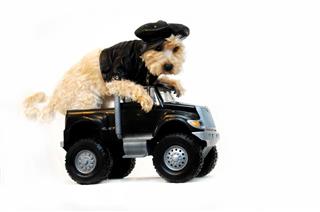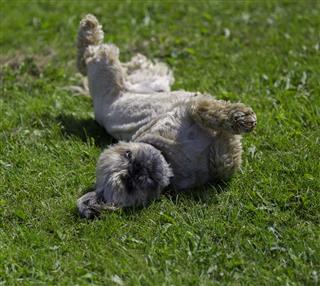
The Shih-poo is a cross between a Shih Tzu and a Toy/Miniature Poodle. DogAppy has everything you need to know before you bring home a Shih Tzu-Poodle pup.
Do not fall for the hypoallergenic promise.
There isn’t a dog that is hypoallergenic, seeing as it is dander which mainly causes allergies. All dogs shed their dead skin cells, which may trigger an allergy. Therefore, do not believe the breeder who tells you that your Shih-poo (or any other breed) is completely hypoallergenic.
The Shih Tzu-Poodle mix is a small dog, being a cross between two small-sized breeds. The Shih Tzu and Toy Poodle were chosen with the hope of obtaining an offspring which would be hypoallergenic. Of course, it is now known that all dogs are hypoallergenic to some extent, and can be regarded as allergy triggers.
The Shih-poo is very energetic and can be affectionate if socialized and trained well. It is a perfect companion for small families, seniors, and those who dwell in apartments. Those looking for a suitable arm candy can go for this dog, since it is one good looker.
Introducing the Shih Tzu-Poodle Mix
A crossbreed can be easily described as a surprise package―you can never know for sure what you’ll end up with. These pups borrow their physical characteristics and temperament from either parents, and in any proportion. Therefore, it is safe to say that you end up with a very unique pet.
APPEARANCE
Depending upon the inherited characteristics, your Shih-poo puppy will have a soft coat of wavy to curly hair. The coat pattern can be solid or variable, with lots of colors, from a dense black to a sandy beige. Like both parents, this crossbreed is unlikely to shed too much, despite the long coat.
The puppy may have a long muzzle like the Poodle, eliminating most breathing problems that come with a short Shih Tzu muzzle. Then again, he may end up with a cute under-bite, a trait consistent with most purebred Shih Tzus.
An adult Shih-poo may measure between 8 – 15 inches at the shoulder, and weigh between 8 – 20 lbs. The overall build is sturdy, with an alert and expressive face.
TEMPERAMENT
With a Shih-poo at home, there will never be a dull moment, as it is a tiny firecracker. It will love all its squeaky toys and play fetch for hours on end. It just loves to run and exercise, and will have explored the nooks and corners of your home in no time.
You need to be watchful when letting the dog play with young children, as it cannot handle misbehavior like rough tugging and hair pulling. As always, teach your children how to properly behave around dogs, especially small ones.
The Shih-poo can be quite a chatty dog, and needs to be specifically trained to keep it down. They may love to bark, and their unending enthusiasm only intensifies it. However, it is your responsibility to train you pup, using force free, positive training.
Being the offspring of Poodles, they will inherit their intelligence, along with the loving nature of the Shih Tzu. If properly trained and socialized at a young age, your pup will most likely have a friendly disposition.
HEALTH AND LIFESPAN

Crossbreeds come with their fair share of problems, and do not let any breeder tell you otherwise. Shih-poos could be susceptible to the health problems which ail both, the Shih Tzu and Toy Poodle. But there’s also a distinct possibility that the genetic diversity achieved by mixing two breeds may lower the chances of developing certain inherited diseases. The vagaries of genetic variation makes things quite complicated.
Always ask for documented proof of a clean bill of health from your breeder. This includes independent certification that the parents of the dog (and grandparents, etc.) have been screened for genetic defects and deemed healthy for breeding.
The breed is deemed susceptible to dental problems, hypothyroidism, patellar luxation, renal dysplasia, and lung disorders. Regular check ups with the vet will always help you keep an update on your pet’s health condition.
The lifespan of a Shih-poo can average between 13 – 16 years.
GROOMING
Your Shih-poo will require professional grooming sessions every 4 – 6 weeks to keep its coat in top condition. The coat requires brushing or combing with a detangling comb every alternate day to prevent mats or tangles, along with regular bathing in between grooming appointments.
You need to brush its teeth regularly, as this crossbreed has a disposition for dental disease. This should preferably be done every alternate day, if not everyday.
You may occasionally spot brownish tear stains below the eyes, which can be cleaned with a soft, wet cloth or a tissue. This is not a cause for alarm, unless you’re observing constant teary eyes―contact the vet in this case. Remember to clean the under-eye area very delicately.


















